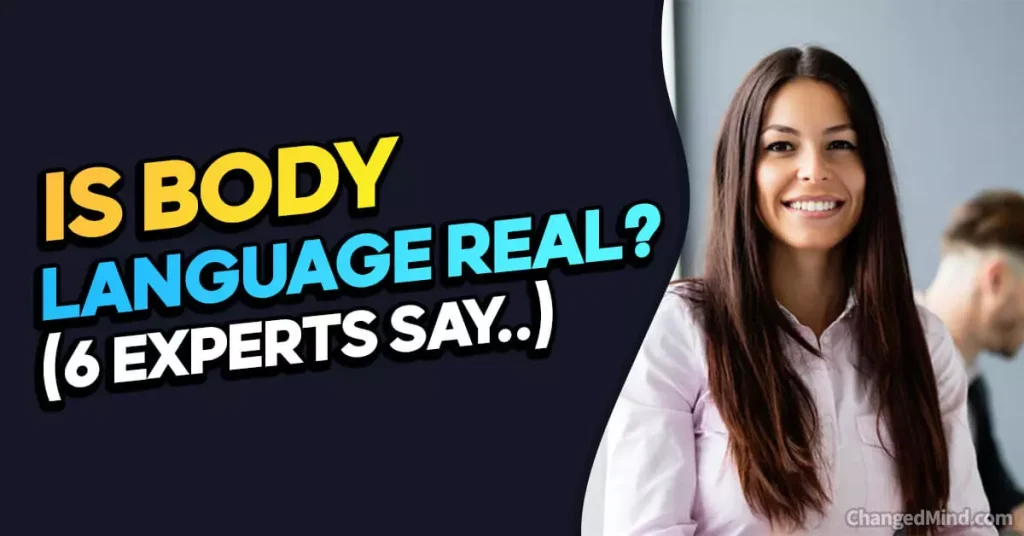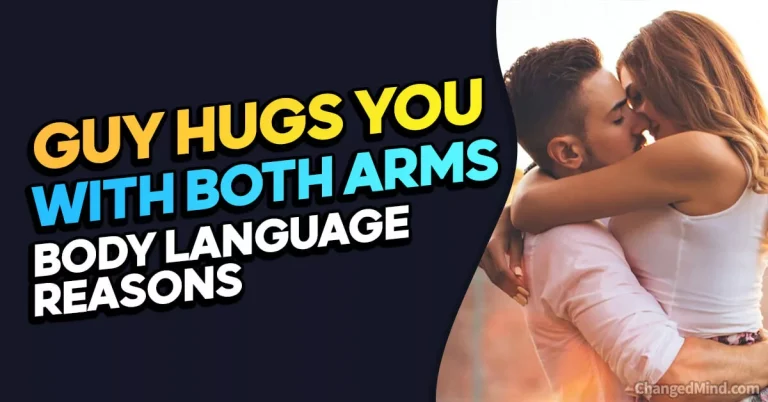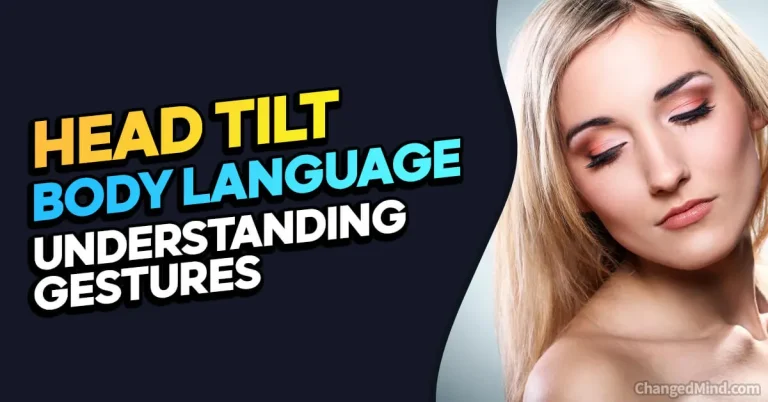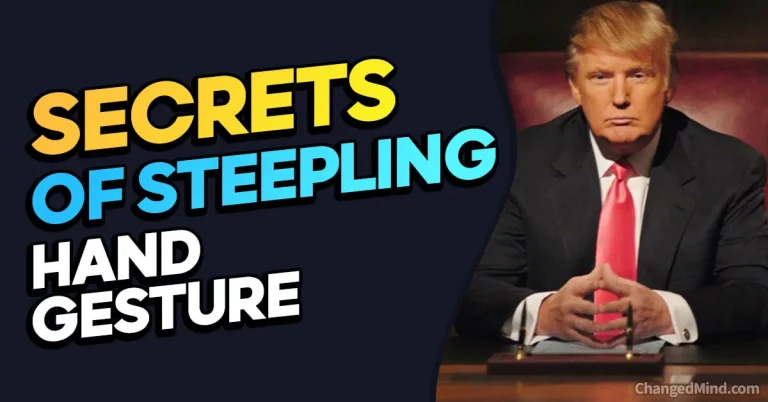Do you wonder, Is Body Language Real or Pseudoscience?
Yes, body language is real and it holds fascinating insights into human communication. But let’s not stop there!
In this article, we dive deep into the world of nonverbal cues, decoding facial expressions, deciphering gestures, and understanding the science behind it all.
Get ready for a captivating exploration as we unravel the truth, debunk myths, and explore how body language impacts our relationships, interactions, and even dating experiences.
Here’s what you can expect to discover:
- The role of culture in interpreting body language
- Scientific evidence supporting the authenticity of nonverbal communication
- Common body language signals and their meanings
- Practical tips for reading and improving your own body language
- Criticisms and misconceptions surrounding body language
- And insights from six experts in the field!
So, if you’re ready to embark on this captivating journey of unraveling the mysteries of body language, read on and let’s decode the fascinating world of nonverbal communication together!
The Silent Power of Nonverbal Communication
Communication goes beyond the mere exchange of words. It encompasses facial expressions, gestures, postures, and even eye contact. Nonverbal cues often reveal more about a person’s thoughts, feelings, and intentions than their verbal utterances alone. In fact, studies suggest that a significant portion of our communication is nonverbal, making it an essential aspect of understanding and connecting with others.
Nonverbal communication plays a vital role in various scenarios. From deciphering emotions in personal relationships to decoding unspoken messages in professional settings, body language can offer valuable insights into people’s true thoughts and attitudes. It’s like having a secret code that, once deciphered, grants you access to a deeper understanding of the world around you.
Understanding Body Language

Decoding the Unspoken: Definition and Explanation of Body Language
Body language, often referred to as nonverbal communication, is the silent language we use to express ourselves without uttering a single word. It encompasses the subtle signals we emit through facial expressions, gestures, postures, and even eye contact. While verbal communication conveys the content of our thoughts, body language reveals the underlying emotions, attitudes, and intentions behind our words.
Consider a scenario where someone tells you they are happy, but their crossed arms, furrowed brows, and downturned lips suggest otherwise. In such instances, it is body language that provides the key to unlocking the truth. Understanding the significance of these nonverbal cues empowers you to grasp the hidden messages conveyed by others and enhances your ability to navigate social interactions with greater insight and empathy.
The Evolutionary Roots of Nonverbal Cues
To comprehend the essence of body language, we must delve into its evolutionary origins. Our ancestors, long before the advent of complex language, relied heavily on nonverbal communication to survive and thrive in their environments. Facial expressions, for instance, served as instinctual and universal signals to convey emotions and intentions, aiding in cooperation, threat detection, and social cohesion.
The primal need to interpret nonverbal cues persists within us today, as these skills remain deeply ingrained in our collective human experience. While our modes of communication have evolved, the core principles of body language have endured, allowing us to tap into a language older than words.
Culture’s Influence on Interpreting Body Language
While certain nonverbal cues possess universal meanings, it is essential to recognize that cultural context plays a significant role in interpreting body language. Cultures vary in their norms and values, which consequently impact the gestures, postures, and expressions deemed appropriate or meaningful within a particular society.
For example, direct eye contact is often perceived as a sign of respect and attentiveness in Western cultures, whereas in some Eastern cultures, it can be seen as impolite or confrontational. Therefore, when interpreting body language, it is crucial to consider the cultural lens through which these cues are observed. By cultivating cultural sensitivity, you can navigate diverse social environments with greater understanding and avoid misinterpretations.
Understanding body language goes beyond a mere surface-level interpretation of nonverbal cues. It involves recognizing the intricacies of human expression, acknowledging the evolutionary underpinnings that have shaped our nonverbal communication, and appreciating the role of culture in shaping our interpretations. As you embark on this journey of deciphering body language, prepare to unlock a world of hidden meanings and gain a profound understanding of the unspoken messages that surround us.
5 Ways You Can Tell Nonverbal Communication Is Real
Nonverbal communication, often conveyed through body language, is indeed a real and powerful aspect of human interaction. Here are five compelling reasons that affirm its authenticity:
1. Universality Across Cultures
Body language displays certain nonverbal cues that are universally recognized across cultures. For instance, a smile generally signifies happiness, while crossed arms may indicate defensiveness or resistance. These common nonverbal signals transcend language barriers, reinforcing the reality of nonverbal communication.
2. Consistency with Verbal Messages
Nonverbal cues align with verbal messages to create a holistic understanding of communication. When someone’s words match their body language, it reinforces the authenticity of their thoughts and emotions. Conversely, inconsistencies between verbal and nonverbal cues can indicate hidden motives or concealed emotions.
3. Emotional Expressions
Facial expressions are a prime example of how nonverbal communication reflects genuine emotions. From a hearty laugh to a furrowed brow, our faces convey a wide range of emotions without uttering a single word. Research consistently supports the authenticity of facial expressions in revealing our inner feelings.
4. Cultural Differences in Body Language
While some nonverbal cues have universal meanings, it’s important to acknowledge the influence of cultural norms. Different cultures may interpret certain gestures or expressions in distinct ways. Understanding and adapting to cultural nuances enriches our understanding of nonverbal communication, highlighting its real and contextual nature.
5. Impact on Relationships and Communication
The profound impact of nonverbal communication on our relationships cannot be overstated. Body language plays a crucial role in building trust, fostering connection, and establishing rapport. By paying attention to nonverbal cues like eye contact, gestures, and postures, we can better navigate social interactions and strengthen our communication skills.
In conclusion, the reality of nonverbal communication, including body language, is firmly grounded in scientific research, cross-cultural observations, and the experiences we encounter in our daily lives. By recognizing its universality, consistency, emotional expressiveness, cultural nuances, and impact on relationships, we can harness the power of nonverbal communication to enhance our understanding and connection with others. So, keep your eyes open, observe the subtle cues, and unlock the hidden language of body signals. It’s real, and it’s waiting to be decoded!
The Science Behind Body Language
Cracking the Code: Research and Studies Supporting the Validity of Nonverbal Communication
Is body language real? You might be wondering if there is scientific evidence to back up its validity. Well, the answer is a resounding yes! Researchers from various fields have conducted studies that provide compelling evidence supporting the significance of nonverbal communication.
One study published in the journal Psychological Science found that people were able to accurately judge the personality traits of strangers solely based on their nonverbal cues. Participants were astoundingly accurate in determining traits like extraversion, agreeableness, and conscientiousness, showcasing the power of body language in conveying information about an individual.
Another study conducted at Princeton University revealed that people form snap judgments about others’ competence and trustworthiness within a mere fraction of a second, solely based on their facial expressions. These lightning-fast impressions influence our interactions and decisions, highlighting the subconscious impact of nonverbal cues on our perceptions.
These studies, among many others, emphasize the scientific basis of body language and its potential to shape our understanding of others. So, the next time you catch yourself judging someone’s character or forming an impression based on their nonverbal cues, know that you’re not just relying on guesswork; there’s actual scientific evidence supporting the authenticity of these interpretations.
The Brain’s Role: Areas Involved in Processing Nonverbal Cues
Ever wondered where in your brain the magic of deciphering body language occurs? Neuroscientists have identified specific regions of the brain that play a crucial role in processing nonverbal cues.
One such area is the fusiform gyrus, located in the temporal lobe. It is responsible for recognizing and processing facial expressions, allowing us to discern emotions conveyed through subtle changes in the muscles of the face. This specialization in facial recognition showcases the brain’s inherent ability to prioritize nonverbal cues as an essential aspect of human interaction.
Additionally, the superior temporal sulcus (STS) plays a crucial role in perceiving and interpreting body movements and gestures. It helps us understand intentions, detect deception, and even empathize with others by analyzing the nuances of their nonverbal behavior.
By unraveling the brain’s involvement in processing nonverbal cues, researchers have provided further evidence of the reality and significance of body language as a valid form of communication.
Universal Nonverbal Signals: Meaning Beyond Words
While cultures may differ in their customs and interpretations of nonverbal cues, certain signals possess universal meanings that transcend geographical boundaries. These cross-cultural nonverbal cues offer insights into our shared human experiences.
For example, a smile tends to convey happiness and friendliness, regardless of cultural background. Similarly, a furrowed brow often indicates confusion or concern, while widened eyes signify surprise. These universal nonverbal signals provide a foundation for understanding and connecting with people from different cultures, allowing us to bridge communication gaps and foster meaningful connections.
By familiarizing yourself with these universal nonverbal signals, you gain a powerful tool for decoding the intentions and emotions of individuals from diverse backgrounds, enhancing your ability to navigate relationships and interactions with greater insight and empathy.
Common Body Language Signals
The Face Tells All: Facial Expressions and Their Emotional Cues
Our faces are a canvas of emotions, painting a vivid picture of what lies beneath the surface. Facial expressions, with their subtle nuances, convey a wealth of information about our internal states. Here are some key facial expressions and the emotions they often reveal:
1. Smile: A genuine smile, characterized by the lifting of the corners of the mouth and the appearance of crow’s feet around the eyes, signifies happiness, warmth, and friendliness. It is an invitation to connect and indicates a positive disposition.
2. Furrowed Brow: When someone’s forehead wrinkles and their eyebrows draw closer, it usually signals confusion, concern, or deep concentration. It indicates that they are actively processing information or trying to make sense of a situation.
3. Raised Eyebrows: Raised eyebrows are often associated with surprise or curiosity. They convey an openness to new ideas or unexpected events. You may notice this expression when someone is pleasantly taken aback or intrigued.
Understanding these facial expressions enables you to decipher the emotions underlying someone’s words or actions. However, it’s important to consider other nonverbal cues in conjunction with facial expressions for a comprehensive understanding of a person’s emotional state.
Speaking Without Words: Gestures and Postures and Their Interpretations
Gestures and postures are like the body’s own language, conveying messages that can often speak louder than words. Let’s explore some common nonverbal cues and their interpretations:
1. Crossed Arms: When someone crosses their arms over their chest, it can indicate defensiveness, discomfort, or a desire to create a psychological barrier. However, it’s essential to consider the context, as crossed arms can also simply signify relaxation or habit.
2. Leaning In: Leaning towards someone during a conversation demonstrates interest, engagement, and a desire to connect. It conveys attentiveness and can foster a sense of rapport and connection with the other person.
3. Nodding: A gentle nod of the head signifies agreement, understanding, and active listening. It shows that you are present in the conversation and validates the speaker’s words.
These are just a few examples of the numerous gestures and postures that contribute to nonverbal communication. Paying attention to these cues allows you to better understand others and adjust your own body language to enhance effective communication and build stronger connections.
Look into My Eyes: Eye Contact and Its Significance
The eyes are often referred to as the windows to the soul, and they play a vital role in nonverbal communication. Here’s why eye contact is so important:
1. Connection and Engagement: Maintaining appropriate eye contact during a conversation fosters a sense of connection and engagement. It shows that you are present and actively involved in the interaction, signaling respect and attentiveness.
2. Trust and Sincerity: Sustained eye contact can convey trustworthiness and sincerity. It assures the other person that you are open and honest, fostering a stronger bond and facilitating meaningful communication.
3. Cultural Considerations: It’s important to note that cultural norms influence the interpretation of eye contact. In some cultures, direct eye contact is a sign of respect and attentiveness, while in others, it may be perceived as impolite or confrontational. Understanding these cultural nuances is crucial for effective cross-cultural communication.
By mastering the art of eye contact, you can enhance your communication skills, build trust, and establish stronger connections with others.
Body language is a complex and nuanced form of communication. By paying attention to facial expressions, gestures, postures, and eye contact, you can gain valuable insights into people’s emotions, intentions, and level of engagement.
Applications of Body Language
Navigating Relationships and Social Interactions
Body language serves as a valuable tool for navigating relationships and social interactions. By understanding and interpreting nonverbal cues, you can gain deeper insights into others’ thoughts, emotions, and intentions, leading to more meaningful connections. Here’s how body language can be applied in your daily interactions:
1. Building Trust: Paying attention to nonverbal cues allows you to assess the trustworthiness of individuals. You can observe consistency between their words and body language, identifying signs of sincerity or potential inconsistencies that may indicate hidden agendas.
2. Expressing Interest: By mirroring positive nonverbal cues, such as leaning in, maintaining eye contact, and nodding, you can demonstrate genuine interest and engagement. This encourages the other person to feel valued and understood, fostering a stronger connection.
3. Resolving Conflicts: Understanding body language can help you navigate conflicts by allowing you to identify signs of agitation or defensiveness. By adjusting your own body language, such as using open gestures and maintaining a calm demeanor, you can de-escalate tense situations and promote more productive dialogue.
Detecting Deception and Hidden Emotions
Body language can be a powerful tool in detecting deception and uncovering hidden emotions. While verbal communication can be carefully crafted, nonverbal cues often reveal the truth. Here’s how body language can help you in this realm:
1. Microexpressions: Microexpressions are fleeting facial expressions that occur involuntarily and reveal true emotions. By observing subtle changes in facial muscles that last for just a fraction of a second, you can catch glimpses of concealed feelings, uncovering potential deception or underlying emotions.
2. Incongruence: Inconsistencies between verbal and nonverbal cues can indicate deception. For example, if someone claims to be confident but displays signs of nervousness, such as fidgeting or avoiding eye contact, they may not be entirely truthful. By noticing these incongruences, you can delve deeper and uncover hidden motives or concerns.
3. Contextual Analysis: By considering the broader context and observing clusters of nonverbal cues, you can gain a more accurate understanding of others’ emotions and intentions. For instance, crossed arms alone may not signify defensiveness, but when combined with a tense jaw, narrowed eyes, and an averted gaze, it paints a clearer picture of someone who is guarded or defensive.
Enhancing Communication and Building Rapport
Effective communication relies not only on words but also on nonverbal cues. Body language can significantly enhance your communication skills and help you build rapport with others. Here’s how you can leverage body language for improved communication:
1. Active Listening: Engage in active listening by maintaining eye contact, nodding, and using appropriate facial expressions. These nonverbal cues show that you are fully present and attentive, encouraging the speaker to share more openly.
2. Adjusting Your Own Body Language: Being mindful of your own body language can positively influence the dynamics of a conversation. Open gestures, relaxed posture, and friendly facial expressions create an inviting atmosphere, fostering trust and rapport.
3. Adapting to Cultural Differences: Cultures vary in their interpretation of body language, so it’s important to be sensitive to these differences. By understanding cultural nuances, you can adapt your own nonverbal cues to ensure effective cross-cultural communication and avoid misunderstandings.
By applying body language techniques in your interactions, you can navigate relationships more effectively, detect deception, and foster meaningful connections. Remember, mastering body language is an ongoing process that requires observation, practice, and the willingness to adapt to different social contexts.
How To Improve Your Nonverbal Communication?
Nonverbal communication, including body language, plays a vital role in our daily interactions. Enhancing your nonverbal communication skills can significantly improve your ability to connect with others and convey your thoughts and emotions effectively. Here are some practical tips to help you improve your nonverbal communication prowess:
1. Be Mindful of Your Body Language
Pay attention to your own body language and the messages it conveys. Here are a few key points to remember:
- Maintain Good Posture: Stand or sit upright with relaxed shoulders and avoid slouching. This projects confidence and openness.
- Use Gestures Purposefully: Employ natural and expressive gestures to complement your verbal messages, but avoid excessive or distracting movements.
- Maintain Eye Contact: Make eye contact to establish a connection, but remember to strike a balance and be mindful of cultural norms.
2. Observe and Interpret Nonverbal Cues
Develop your ability to observe and interpret nonverbal cues in others. Here’s how:
- Pay Attention to Facial Expressions: Facial cues provide valuable insights into someone’s emotions. Notice microexpressions and subtle changes in the face.
- Read Body Language Clusters: Look for clusters of nonverbal cues that reinforce a particular message or emotion. Consider gestures, postures, and facial expressions together for a more accurate interpretation.
- Consider Context and Individual Differences: Remember that nonverbal cues can vary based on cultural background and individual personality traits. Consider the context and the person’s unique communication style.
Expert Says
Licensed Marriage and Family Therapist | Founder, The Relationship Place

3. Practice Active Listening
Active listening is crucial for effective communication. Use nonverbal cues to enhance your listening skills:
- Maintain Open Body Language: Signal that you are engaged and attentive by facing the person, leaning slightly forward, and nodding occasionally to show understanding.
- Mirror Nonverbal Cues: Subtly mirror the other person’s body language to establish rapport and create a sense of connection.
- Show Empathy: Use facial expressions and gestures to convey empathy and understanding. This helps the other person feel heard and validated.
4. Seek Feedback and Learn from Others
Don’t be afraid to ask for feedback on your nonverbal communication skills. Here’s how you can learn from others:
- Observe Skilled Communicators: Pay attention to individuals known for their excellent nonverbal communication skills, such as public speakers or actors. Learn from their techniques and incorporate them into your own style.
- Engage in Role-Playing Exercises: Practice nonverbal communication in safe environments, such as workshops or group activities, to receive feedback and improve your skills.
5. Enhance Your Emotional Awareness
Emotions are often expressed through nonverbal cues. Strengthen your emotional awareness to better understand others and express yourself:
- Recognize and Label Emotions: Develop your emotional intelligence by identifying different emotions in yourself and others. This helps you respond appropriately and empathetically.
- Regulate Your Emotions: Learn techniques to manage your own emotions effectively. This can positively impact your nonverbal communication, as your body language often reflects your emotional state.
Expert Says
Silvi Saxena, MBA, MSW, LSW, CCTP, OSW-C
Licensed Social Worker | Certified Clinical Trauma Professional, Choosing Therapy

By implementing these tips and practicing regularly, you can significantly improve your nonverbal communication skills. Remember, it’s a journey of continuous learning and refinement. With time and effort, you’ll become a proficient communicator, adept at both verbal and nonverbal aspects of communication.
Criticisms and Skepticism
Arguments Against the Credibility of Body Language
While body language has gained significant recognition and acceptance, it is not without its fair share of criticisms and skepticism. Let’s explore some common arguments against the credibility of body language:
1. Subjectivity: Critics argue that interpreting body language is highly subjective, as it relies on individual perception and cultural context. They suggest that what one person considers a particular gesture or expression to mean may be interpreted differently by another, leading to potential miscommunications or misunderstandings.
2. Context Dependence: Skeptics claim that nonverbal cues can be heavily influenced by the specific context in which they occur. They argue that certain gestures or expressions may hold different meanings depending on the situation or cultural background, making it challenging to attribute universal significance to specific body language signals.
Addressing Misconceptions and Limitations
While it is true that body language interpretation is not an exact science, it is important to address the misconceptions and limitations surrounding its practice. Here’s what you need to know:
1. Complementary Nature: Body language should not be viewed in isolation but rather as a complement to verbal communication. It adds depth and richness to our understanding of others’ thoughts and emotions. By considering both verbal and nonverbal cues together, we can form a more accurate interpretation.
Expert Says
Emily Simonian, LMFT
Licensed Marriage and Family Therapist, Thriveworks

2. Cultural Awareness: Recognizing the influence of cultural norms is crucial when interpreting body language. It’s important to exercise cultural sensitivity and understand that certain gestures and expressions may carry different meanings across various cultures. Being aware of these cultural nuances helps avoid misinterpretations and fosters effective cross-cultural communication.
3. Individual Differences: Each person has unique body language patterns influenced by their personality, experiences, and cultural background. It is essential to consider individual differences when interpreting body language. What may be true for one person may not apply universally to all individuals.
Balancing Body Language with Verbal Communication
While body language provides valuable insights, it is essential to strike a balance between nonverbal cues and verbal communication. Here’s how you can achieve that balance:
1. Active Listening: Pay attention not only to the nonverbal cues but also to the actual words being spoken. Active listening involves understanding the content of the conversation, asking clarifying questions, and providing verbal responses that demonstrate engagement and understanding.
2. Contextual Understanding: Consider the broader context when interpreting body language. Be aware of the situational factors, the relationship between the individuals involved, and any additional information that may influence the meaning of nonverbal cues.
3. Flexibility: Remain flexible in your interpretations and avoid jumping to conclusions based solely on nonverbal cues. Nonverbal communication can be complex and multifaceted, so be open to alternative explanations and seek further clarification when necessary.
By acknowledging the criticisms, addressing misconceptions, and integrating body language with verbal communication, you can achieve a more holistic understanding of others and enhance the effectiveness of your interactions.
Expert Says
Sharonda “Nya B” Brown, MA, NCC, LPC
Licensed Mental Health Clinician and National Board Certified Counselor

While skepticism exists, it’s important to remember that body language, when understood within its appropriate context and in conjunction with verbal communication, can provide valuable insights into human behavior, emotions, and intentions.
Practical Tips for Reading Body Language
Now that you have a deeper understanding of body language, let’s explore some practical tips to help you become more proficient in reading and interpreting nonverbal cues. These tips will sharpen your observation skills, allowing you to gain valuable insights into others’ thoughts, emotions, and intentions.
Observing Clusters of Nonverbal Cues
To accurately read body language, it’s important to observe clusters of nonverbal cues. Individual gestures or expressions may not provide the complete picture, but when multiple signals align, they strengthen the message being conveyed. Here are some tips for observing clusters of nonverbal cues:
- Look for Consistency: Pay attention to the consistency between different nonverbal cues. Do they align with each other and with the verbal messages being conveyed? Consistency increases the likelihood that the signals are genuine and reflect the person’s true thoughts and emotions.
- Consider Congruence: Assess whether the nonverbal cues align with the context of the situation. Are they congruent with the individual’s personality and cultural background? Taking these factors into account helps you form a more accurate interpretation.
- Identify Contradictions: Be alert to contradictions between verbal and nonverbal cues. Incongruences may indicate deception or hidden emotions. For example, if someone claims to be excited about an opportunity but displays closed body language and avoids eye contact, there may be underlying doubts or reservations.
Paying Attention to Context and Individual Differences
Understanding the context and recognizing individual differences are key to interpreting body language effectively. Here are some tips for doing so:
- Consider the Environment: Take into account the specific environment in which the nonverbal cues are being displayed. Social, professional, or personal settings may influence how people express themselves nonverbally. Adapt your interpretations accordingly.
- Be Mindful of Cultural Norms: Different cultures have unique nonverbal communication norms. Educate yourself about cultural differences and avoid making assumptions based on your own cultural background. Respect and adapt to cultural norms to ensure accurate interpretation.
- Account for Individuality: Remember that each person has their own unique body language patterns influenced by personality, experiences, and preferences. Avoid generalizations and consider individual differences when interpreting nonverbal cues. Get to know the person and their baseline behavior to better understand their nonverbal communication style.
Practicing Active Listening and Empathy
Active listening and empathy are crucial for fully understanding and connecting with others. Here’s how you can integrate these skills with body language reading:
- Maintain Eye Contact: Engage in active listening by maintaining appropriate eye contact. It demonstrates your attentiveness and shows respect for the person speaking.
- Listen Beyond Words: While paying attention to nonverbal cues, listen actively to the verbal content of the conversation. The words used provide valuable context and meaning that complement the nonverbal signals.
- Show Empathy: Put yourself in the other person’s shoes and try to understand their perspective. Empathy allows you to connect with their emotions and experiences, enhancing your ability to interpret their body language accurately.
By incorporating these practical tips into your interactions, you’ll sharpen your body language reading skills and deepen your understanding of others. Remember, practice is key. Observe, learn, and refine your interpretations over time. With patience and persistence, you’ll become more adept at deciphering the intricate language of nonverbal cues.
Conclusion
Congratulations! You’ve now delved into the intriguing world of body language and nonverbal communication. Let’s recap the key points we’ve discussed and explore some final thoughts on the reality of body language.
Recap of Key Points
Throughout this article, we’ve covered a range of topics related to body language, providing you with valuable insights and practical tips for understanding and interpreting nonverbal cues. Here’s a quick recap of the key points:
- Understanding Body Language: We explored the definition of body language and its role in our daily interactions. Body language encompasses facial expressions, gestures, postures, and eye contact, all of which contribute to our nonverbal communication.
- The Science Behind Body Language: We examined the scientific research and studies that support the validity of body language. Areas of the brain involved in processing nonverbal cues were identified, and examples of universal nonverbal signals and their meanings were discussed.
- Common Body Language Signals: We explored the significance of facial expressions, gestures, and eye contact in conveying emotions and intentions. Understanding these nonverbal cues allows for more accurate interpretations of others’ thoughts and emotions.
- Applications of Body Language: We discovered how body language can be applied in various areas of life, such as navigating relationships and social interactions, detecting deception and hidden emotions, and enhancing communication and building rapport.
- Criticisms and Skepticism: We addressed some of the criticisms and skepticism surrounding body language, acknowledging the subjective nature and context dependence of nonverbal cues. We also discussed how to address misconceptions and limitations.
- Practical Tips for Reading Body Language: We provided you with practical tips to improve your body language reading skills. By observing clusters of nonverbal cues, paying attention to context and individual differences, and practicing active listening and empathy, you can enhance your ability to interpret nonverbal communication.
Final Thoughts on the Reality of Body Language
While there may be skeptics who question the credibility of body language, the overwhelming body of scientific research and real-life observations support its authenticity. Body language is a natural part of human communication, deeply rooted in our evolutionary history and cultural contexts. While there may be individual variations and cultural nuances to consider, the universality of certain nonverbal cues cannot be denied.
Understanding and applying body language knowledge can have a profound impact on your personal and professional relationships. By reading nonverbal cues, you can gain insights into others’ thoughts, emotions, and intentions, allowing for more effective communication and building stronger connections.
Apply Your Body Language Knowledge
Now that you have a solid understanding of body language, it’s time to put your knowledge into practice. Observe the nonverbal cues in your daily interactions, paying attention to clusters of signals and considering the context and individual differences. Practice active listening and empathy, and be mindful of the impact your own body language has on others.
Remember, becoming proficient in reading body language is an ongoing process. The more you observe, practice, and refine your skills, the better you’ll become at deciphering the intricate language of nonverbal communication.
So, go ahead and apply your newfound body language knowledge. Unlock the secrets hidden beneath the surface of nonverbal cues, and enjoy the deeper connections and understanding that come with it. Happy reading!
FAQ
Is body language a reliable indicator of someone’s thoughts and emotions?
Body language provides valuable insights, but it’s not foolproof. It must be interpreted within context, considering individual differences and cultural norms. It complements verbal communication for a more comprehensive understanding.
Can body language be faked or manipulated?
Yes, body language can be consciously controlled and manipulated. People may hide their true thoughts or emotions through deceptive cues. However, inconsistencies with verbal messages or clusters of nonverbal cues can reveal incongruences.
Are there universal nonverbal signals that hold the same meaning across cultures?
While some nonverbal signals have universal meanings, cultural norms play a significant role. Gestures or expressions may differ in interpretation across cultures, so it’s crucial to consider cultural context when interpreting body language.
Can body language be learned and improved upon?
Absolutely! By observing, practicing, and studying nonverbal cues, anyone can enhance their body language reading skills. It’s a continuous learning process that requires attention, awareness, and a willingness to adapt to different situations.
Can body language misconceptions lead to misunderstandings in communication?
Yes, misinterpreting body language can lead to misunderstandings. It’s important to avoid jumping to conclusions and to seek clarification when in doubt. Combining body language with active listening and open communication promotes effective understanding.

Disclaimer
This information is for educational purposes only and is not intended to be a substitute for clinical care. Please consult a health care provider for guidance specific to your case.






